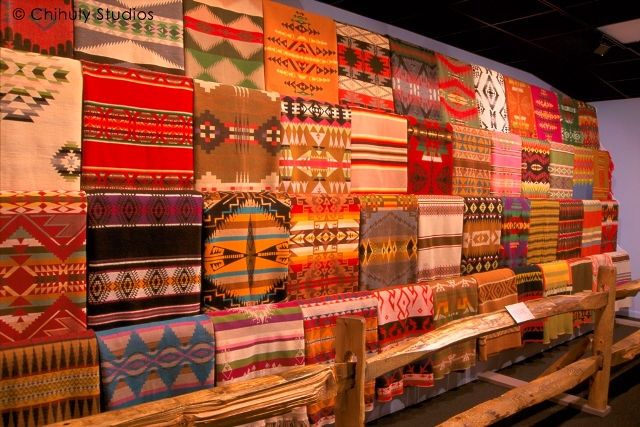Mayborn Museum Complex Announces Summer Exhibit

Baylor University's Mayborn Museum Complex will host the summer traveling exhibit, "Wrapped in Tradition: The Chihuly Collection of American Indian Trade Blankets," in the Thomas E. and Emilyne Weed Anding Traveling Exhibit Gallery from May 20-Aug. 18.
by Sarah Levine, director of marketing, Mayborn Museum, (254) 710-2517
Baylor University's Mayborn Museum Complex is pleased to announce its 2007 summer traveling exhibit - Wrapped in Tradition: The Chihuly Collection of American Indian Trade Blankets - which will be on display in the Thomas E. and Emilyne Weed Anding Traveling Exhibit Gallery at the museum from May 20-Aug. 18.
American artist Dale Chihuly is credited, more than any other individual, with transforming glass into a material considered suitable for fine rather than decorative art. The "Cylinders" were his first series of work, originated in 1975 and continuing to the present. Chihuly describes the technique and the process: "We created drawings inspired by Indian blanket designs, using glass threads that we then picked up onto the surface of the hot cylinders. The pickup technique lent itself very nicely to making geometric patterns, as many simple techniques do."
Vibrant color and geometric design also describe Chihuly's exquisite glass cylinders. "Looking back, I think it is possible to say that...the pieces were wearing their drawings just as the Indians were wearing their blankets," Chihuly reflected. Fifteen of these artworks spanning years will be on display.
Inspired by Navaho weaving, Chihuly began collecting machine-made blankets, first made for the European-Native American trade. Traditional hand-woven blankets made by American Indians used basic weaving techniques and organic colors to produce their geometric designs. However, the sophisticated looms and more modern dyes used by several companies, most notably the Pendleton Company, allowed them to produce blankets that were much more complex in design and more vibrant in color.
Although the companies often used simpler designs to imitate the traditional blankets, the finer weave and brighter colors were more desirable to the American Indians. The unusual colors were one of the most attractive features to the Indians, and they often preferred wearing the manufactured blankets to their own hand-woven blankets.
"It is with great excitement that we bring this extraordinary exhibit to Central Texas," said Dr. Ellie Caston, director of Baylor's Mayborn Museum Complex. "The lasting beauty and historical importance of these blankets are the perfect compliment to our natural history exhibits and our interactive discovery rooms. It shows how the craft of weaving blankets was inspired by nature, and the art of blowing the glass cylinders was inspired by the craft."
For more information about the exhibit, contact the Mayborn Museum Complex at (254) 710-1110 or visit www.baylor.edu/mayborn. The Mayborn Museum Complex is located on the Baylor campus at 1300 S. University Parks Dr.